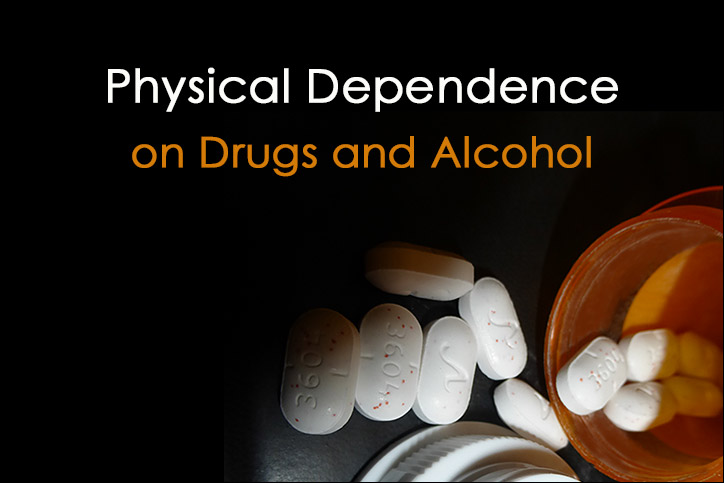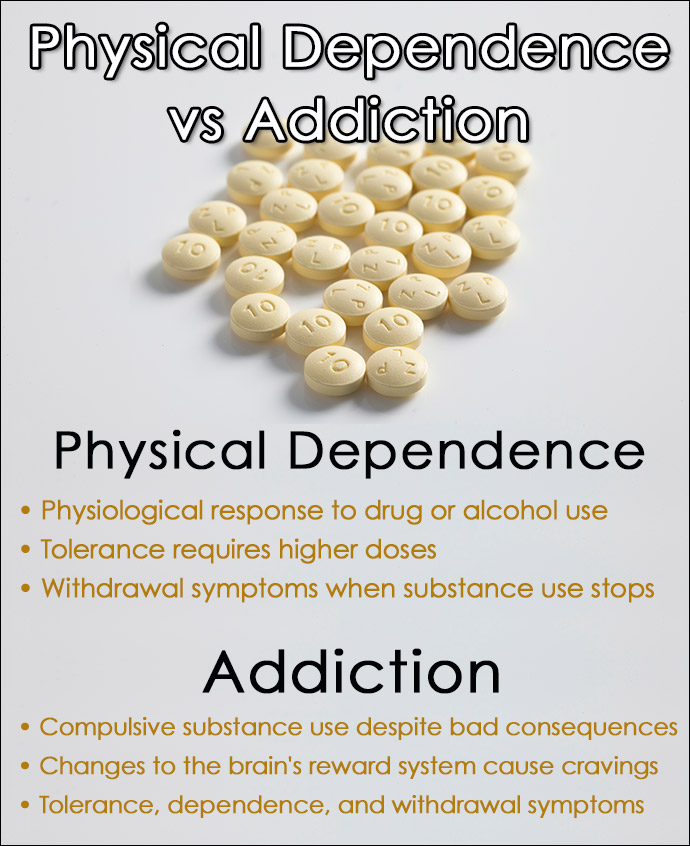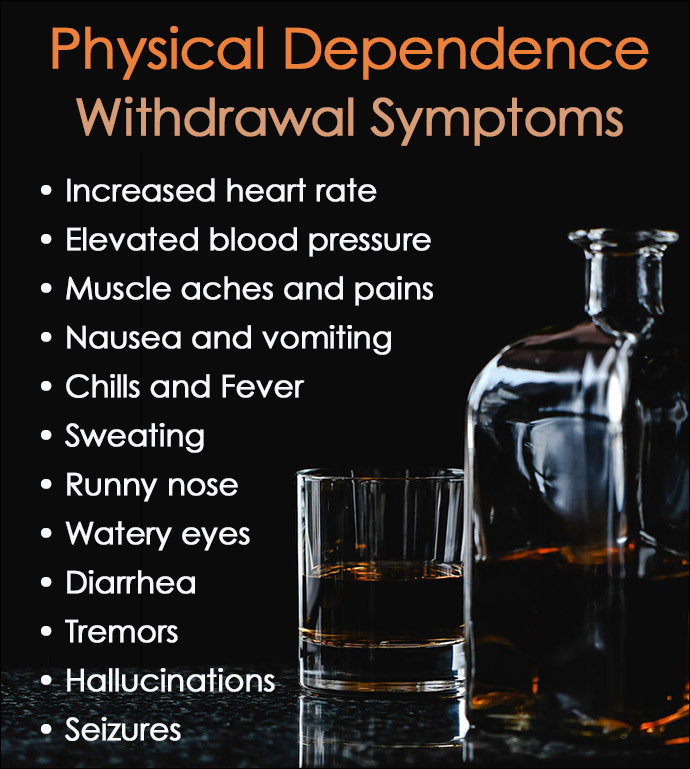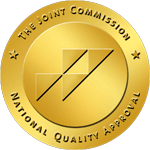Table of Contents
Physical dependence on drugs and alcohol is a condition caused by prolonged or excessive use of addictive substances.
There is a difference between physical dependence vs addiction, although the two are closely related, so it’s necessary to understand the distinction.
It’s also important to identify the symptoms of physical dependence and to seek treatment if they occur to avoid advancing to the more serious condition of addiction (substance use disorder).
Treatment for dependence and addiction are very similar, yet addiction is more complex, and healing or recovery can take longer than for physical dependence.
What is Physical Dependence?
Physical dependence is a condition that occurs when the body becomes physically dependent on drugs or alcohol to function normally.
It results from continued use or abuse of alcohol, legal prescription medications such as painkillers or antidepressants, or illegal drugs like heroin and fentanyl.
This type of substance reliance is different from a mental or psychological dependence on alcohol or drugs and is marked by physical symptoms rather than the emotional distress of anxiety or depression caused by substance use.
Many people consider dependence to be the same as addiction, and even though they’re similar, they are different conditions. People can become physically dependent on drugs or alcohol without being addicted to them.
Physical dependence is marked by two main characteristics: tolerance and withdrawal symptoms.
1. Tolerance
Tolerance develops after substance use causes the body to need larger amounts of alcohol or higher doses of a drug to feel the same effects as when the person first started using them.
2. Withdrawal Symptoms
Withdrawal symptoms appear when an individual stops taking a substance they are physically dependent on and can range from mild to severe depending on the substance and length of time they have been using it.
Difference Between Physical Dependence vs Addiction
Drug and alcohol use can lead to both physical dependence and addiction. Despite some of the shared similarities and overlapping features, they are distinct conditions.
It’s possible to be physically dependent on a drug and not be addicted to it. A person can also be addicted to a drug and not be physically dependent on it, yet this is less common and generally only occurs with certain drugs like cocaine.
To understand the difference between physical dependence vs addiction, it’s necessary to examine the characteristics of each condition.
Physical Dependence
- The body’s physiological response to regular use of drugs or alcohol
- Tolerance develops requiring higher doses to feel the same effects as when a person started using it
- Withdrawal symptoms appear when substance use has stopped
Addiction
According to the National Institute on Drug Abuse, addiction is a chronic, relapsing disorder characterized by compulsive drug seeking and use despite adverse consequences.
Addiction causes functional changes to the brain related to reward and self-control that may continue after a person stops taking drugs.
- Compulsive substance use, despite negative consequences
- Functional changes to the brain’s reward system that cause cravings and continued use
- Usually entails tolerance, dependence, and withdrawal symptoms when substance use has stopped
In essence, a physical dependence on alcohol or drugs is a physiological condition related to the body’s response to tolerance and withdrawal symptoms when substance use has stopped.
Addiction often includes a dependence, but also encompasses functional brain changes, psychological cravings, and drug seeking behavior.
Physical Dependence Symptoms
The main symptoms of physical dependence on drugs and alcohol include tolerance and withdrawal when the substance use has stopped.
Tolerance simply means the body needs more of the substance to feel the same effects as when a person first started using it.
If an individual became drunk after drinking 3 beers previously, but now needs 6 beers to feel the same level of intoxication, it is a clear sign they have developed a tolerance.
Physical dependence withdrawal symptoms are much more complex and can lead to a number of different health issues.
The symptoms of physical dependence can vary from mild to severe and are often related to the type of substance they are dependent on, as well as the amount and duration of use, and overall health factors.
Physical Dependence Withdrawal Symptoms can include:
- Increased heart rate
- Elevated blood pressure
- Sweating
- Runny nose
- Watery eyes
- Muscle aches and pains
- Nausea and vomiting
- Diarrhea
- Tremors
- Chills and Fever
- Hallucinations
- Seizures
Marijuana and stimulants like Adderall and cocaine usually have the mildest physical withdrawal symptoms compared to other substances.
Opioids, such as prescription painkillers, heroin, and fentanyl can cause painful withdrawal symptoms like a bad case of the flu.
Long-term, excessive use of alcohol and benzodiazepines can be the most dangerous substances and often require professional detox for safe withdrawal and to avoid seizures.
Substances That Cause Physical Dependence
Both legal and illegal substances can lead to dependence and withdrawal when used for a prolonged period.
Some substances create a mild dependence while others are much more extreme.
Examples of Physically Dependent Drugs and Side Effects
Alcohol – Tremors, seizures, hallucinations, and delirium tremens symptoms.
Antidepressants (Clonidine) – Dizziness and muscle aches.
Benzodiazepines (Xanax, Valium, Klonopin) – muscle aches and possible dangerous withdrawal symptoms that include seizures.
Caffeine – Fatigue and headaches.
Marijuana – Low chance of becoming physically dependent although it’s possible from long-term, excessive use.
Nicotine – Physical cravings, headaches, constipation, or diarrhea.
Opioids (Oxycodone, Morphine, Heroin, Fentanyl) – Nausea, vomiting, muscle aches, severe pain, and intense flu-like symptoms.
Stimulants (Adderall, Cocaine, Methamphetamine) – Fatigue and physical cravings.
Treatment for Physical Dependence
Treatment for physical dependence on alcohol and drugs uses many of the same methods as addiction, even though the conditions are slightly different.
The most appropriate treatment plan will offer a combination of the following:
- Medical Detox
- Medication-Assisted Treatment (MAT)
- Cognitive and Behavioral Therapy
- Holistic Therapy
- Relapse Prevention
Medical Detox
A medically supervised detox is usually the first step of any treatment program to ensure the safety and comfort of the patient during withdrawal.
This is especially important for alcohol and benzodiazepines because alcohol and benzo withdrawal can be dangerous or fatal in certain instances.
This is why alcohol detox at home is not recommended.
Medication-Assisted Treatment (MAT)
The use of medications during detox and treatment can reduce painful withdrawal symptoms and improve patient recovery outcomes.
Naltrexone and buprenorphine are sometimes used to minimize opioid dependence cravings.
The short-term use of benzodiazepines can be beneficial for easing withdrawal symptoms and the negative effects of alcohol.
Cognitive and Behavioral Therapy
Cognitive Behavioral Therapy (CBT), Dialectical Behavior, and other evidence-based treatments are helpful for changing unhealthy thinking and behaviors related to dependence and addition.
CBT techniques are most effective for psychological dependence but they can be useful for treating physical issues too.
Holistic Therapy
There are many holistic treatment approaches and lifestyle changes that complement formal therapies for recovery.
Regular exercise, eating a healthy diet, getting proper sleep, and practicing meditation and mindfulness can all improve mental and physical health during treatment.
Relapse Prevention
Relapse prevention is an important part of many non 12 step rehab programs and it focuses on recognizing substance triggers and cravings and teaches techniques to avoid a relapse.
Treatment for physical dependence is most effective when started at the first sign of tolerance and withdrawal when trying to quit using drugs or alcohol.
Frequently Asked Questions
What is the definition of physical dependence?
Physical dependence is defined as a physical condition caused by the body’s adaptation to chronic use of a substance, resulting in tolerance and withdrawal symptoms when use is reduced or stopped.
What are the long-term effects of physical dependence on the body?
The long-term effects of physical dependence on the body include:
1. Heart problems that include high blood pressure, risk of stroke, and coronary artery disease.
2. Liver disease, fatty liver, alcoholic hepatitis, cirrhosis, and liver cancer.
3. Neurological issues, memory problems, depression, anxiety, and Wernicke-Korsakoff syndrome.
4. Kidney damage and kidney failure.
5. Respiratory disease and decreased lung capacity.
6. Gastrointestinal issues that cause chronic nausea, vomiting, abdominal pain, constipation, and diarrhea.
How does physical dependence differ from psychological dependence?
Physical Dependence
Physical dependence refers to the body developing a tolerance to drugs or alcohol over time and the appearance of physical withdrawal symptoms when substance use is reduced or stopped.
Withdrawal symptoms are physical in nature, such as nausea, vomiting, and increased heart rate and blood pressure.
The most important aspect of physical dependence treatment is focused on detox to manage physical withdrawal symptoms, although other therapies are also important for lasting recovery.
Psychological Dependence
Psychological dependence refers to the emotional and psychological aspects of dependence and addiction, such as mental cravings and being unable to quit using substances.
Behavioral and emotional symptoms are related to mood, depression, anxiety, irritability, and obsessive thoughts.
Psychological dependence is more closely associated with the true nature of addiction and compulsive substance use despite negative consequences.
Treatment for psychological dependence relies more heavily on therapies and lifestyle changes that target the root causes of negative thinking and unhealthy behaviors.





